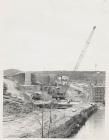The M4 Motorway
Items in this story:
The development of the M4
Roads do not often get much attention from historians but they are central to the lives of individuals and the M4 has been central to the life of post-war Wales.
Plans to upgrade the road system of Britain were developed between the two world wars but were held back by cost and the relatively small volume of traffic using the existing network. Nonetheless, there was a recognition that improvements were needed and that they would be helpful in improving trade in depressed areas such as south Wales.
The concept of a motorway system was first accepted by government in 1942 and a route from London to Swansea, including a bridge across the Severn, was part of its plans. Financial constraints held back any significant progress in the 1950s, although there were piecemeal developments such as dual carriageway Neath bypass which opened in 1956 and the Earlswood to Lonlas road which opened in 1960.
It was the Port Talbot bypass which opened in 1966 that perhaps marked the first significant advance of motorway provision in Wales, although it was still then known as the A48(M). It was quickly followed by the Severn Bridge, which also opened in 1966.
The commissioning of these sections predated the creation of the Welsh Office in 1964 but that piece of administrative devolution became central to the continued motorway expansion in Wales. The mid 1960s saw Wales experience economic problems brought about by the restructuring of the economy in the wake of the first stages of the decline of the coal industry. This led the Welsh Office to commit to extending the M4 beyond Tredegar Park, which was initially envisaged as its westerly limit by government in London.
The remaining sections of the M4 with gradually completed over the next thirty years, with the sections where traffic was heaviest given priority. 1977 proved a significant year when 31 miles were completed. The filling in of the ‘Baglan gap’ in 1994 completed the 80-mile stretch of the M4 in south Wales.
By the 21st century, the short-sightedness of savings made by building some sections of the M4 with two rather than three lanes was apparent and congestion was again a significant problem. Plans for a relief motorway across the Gwent Levels were abandoned because of cost and the environmental impact but other new upgrades had to be implemented around Cardiff to bring the motorway up to three lanes in one of its busiest sections.
The Severn Bridges
The engineer Thomas Telford had suggested a bridge across the Severn in the 1820s but it was another hundred years before local authorities began discussing the idea seriously.
Once motorway developments began to actually happen in the 1950s, the M50 was given priority over the Severn Bridge. That road was important in opening up the Midlands to Wales but its impact would be limited as long as the roads within Wales itself were substandard. Priority was also given to the Forth Bridge over the Severn Bridge and it was not until 1961 that the Ministry of Transport gave the go ahead for a Severn crossing after pressure from the Industrial Association of Wales and Monmouthshire.
The £8m Severn Bridge opened in 1966 and cut the journey from south Wales to London by 55 miles. It was an engineering marvel and one of the most important constructions of the 1960s.
There were some who feared that it would further the cultural integration of Wales into England, especially after it generated debate around the possibility of creating a ‘Severnside’ economic region that embraced Newport and Bristol. However, the bridge also became a powerful symbol of the modernisation of Wales and its economy.
The Severn Bridge had been intended to carry 5 to 10 million crossings a year, but by 1996 it was carrying 18 million. At peak times there could be a six mile queue of vehicles waiting to pay their tolls. There were also regular delays caused by high winds and maintenance work.
A second Severn bridge was thus opened in 1996. Its cost, including all its ancillary work and approach roads, was £428.3m. Much of the cost of the bridge itself was borne by private investment in return for the right to charge tolls for crossings. The fact that these were only paid when entering Wales became the subject of much humour.
The Significance of the M4
Compared with many other road developments, the building of the M4 raised little opposition despite requiring the compulsory purchase of houses along its route and its fairly brutal dissection of Port Talbot with the only stretch of genuinely urban motorway anywhere in Britain.
The M4 came to be seen as an‘economic lifeline’ that joined south Wales to the wider world. It boosted economic development in those towns close to it. In Cardiff, the local authorities invested significant resources in building their own link roads to ensure the motorway’s benefits would not bypass the city and its new Bay development.
Further west, the M4’s economic impact was less stark because of the greater distance from English markets. However, it was the industrial valleys that felt most marginalized by the way economic development in the south clustered along the motorway corridor.
The M4 also raised questions about road links within Wales. In both north and south the main routes ran east-west and north-south links within Wales are extremely poor. The economic and environmental arguments against a major new highway to unite north and south Wales are strong but the orientation of the Welsh road network remains problematic for the physical and cultural unity of Wales.
By Martin Johnes, Swansea University
Further reading
Brian Hawker and Howard Stevens, The Motorway Achievement: Building the Network in Wales (Chichester: Phillimore, 2010).
Martin Johnes, Wales since 1939 (forthcoming).
The Motorway Archive www.motorwayarchive.ihtservices.co.uk/m4wales.htm


